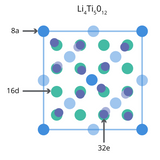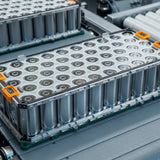Anode Active Materials
Anode active materials are essential to the performance of every high-efficiency battery. Our advanced anode materials deliver the reliability and energy efficiency required for next-generation energy storage systems. They are optimized for use in lithium-ion (LIB), sodium-ion (SIB), lithium-air, lithium-sulfur, and multivalent metal battery technologies.
In liquid-state lithium-ion batteries, the anode and cathode are separated by a polymer-based membrane filled with an electrolyte containing lithium salts in alkyl organic carbonates. The anode active material stores lithium ions through intercalation during charging. To ensure stability and safety, it must withstand repeated cycling with minimal volume change.
Key Features and Applications
- We offer carbon-based materials such as graphite as a major anode material, celebrated for its low cost, lightweight, low working potential, and durability – the ideal choice for standard lithium-ion battery applications.
- High purity, battery grade metal oxide nanoparticles are used to enhance battery capacity, stability and more.
- Our lithium titanium oxide anode material offers exceptional safety and cycling stability. With surface modification and doping, it exhibits improved ion diffusion and conductivity, enhancing high-rate performance.
- Transition metal dichalcogenides layered structures allow for ion intercalation and have gained interest for use in hybrids.
Jump to: Browse Anode Active Materials | Resources and Support
Browse Anode Active Materials
Related categories: battery materials, cathode active materials, sodium-ion battery materials
Filter by price change:
Filter by Type:
Page 1 of 2
Resources and Support
 Anode Materials
Anode Materials
The anode is the electrode where oxidation (loss of electrons) occurs, meaning it releases electrons during battery discharge. Anode materials are essential for facilitating this process and play a central role in determining a battery’s overall performance, capacity, stability, and safety.
Read more... What is an LTO Battery?
What is an LTO Battery?
An LTO battery is named after its key component, lithium titanium oxide (LTO) powder. The material is also referred to as lithium titanate with the chemical formula Li4Ti5O12. Unlike most lithium-ion battery materials it is used as the anode active material.
Learn more...Lithium plating is a mechanism of degradation in lithium-ion batteries (LIBs). It describes the accumulation of metallic lithium on the surface of the anode (usually graphite powder). Lithium ions gather at the anode surface and form metallic deposits.
Learn more...A solid electrolyte interphase (SEI) forms on the negative electrode in lithium-ion batteries (LIBs) due to the decomposition of electrolyte. The decomposition by-products build up on the surface of the anode and form an independent phase of material, different to the electrode and electrolyte.
Read more... Graphene Batteries
Graphene Batteries
Graphene batteries are advanced energy storage devices. Graphene materials are two-dimensional and are typically made solely of carbon.
Read more...Solid-state batteries (SSBs) differ from conventional lithium-ion batteries (LIBs) in terms of both their components and fundamental design features. Instead of a liquid electrolyte, they use a solid electrolyte to conduct lithium ions between electrodes.
Learn more...Lithium-polymer (LiPo) batteries are a type of lithium-ion battery technology that uses polymer electrolytes. This differs from standard lithium-ion batteries which use a solvent based electrolyte. Polymer electrolytes used are highly ionically conductive and form lithium-ion conduction channels.
Learn more... What is a Carbon Nanotube Battery?
What is a Carbon Nanotube Battery?
Carbon nanotubes (CNTs), such as single-walled carbon nanotubes (SWCNT), have been tipped as one of the most exciting nanomaterials in the development of battery technology. The key properties of CNTs that make them ideal candidates as battery components is their high electron conductivity, high strength and lightweight nature.
Learn more...Internal resistance of a battery is one indicator of a battery’s current-carrying capacity. There is an inverse relationship between the two parameters.
Learn more...


































